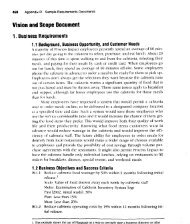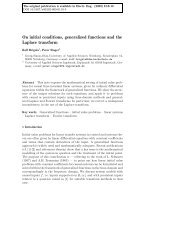Establishing the Product Vision and Project Scope
Establishing the Product Vision and Project Scope
Establishing the Product Vision and Project Scope
You also want an ePaper? Increase the reach of your titles
YUMPU automatically turns print PDFs into web optimized ePapers that Google loves.
Chapter 5 <strong>Establishing</strong> <strong>the</strong> <strong>Product</strong> <strong>Vision</strong> <strong>and</strong> <strong>Project</strong> <strong>Scope</strong> 87<br />
accommodate <strong>the</strong>m, with corresponding changes in budget. schedule, <strong>and</strong><br />
staff. Keep a record of rejected requirements <strong>and</strong> why <strong>the</strong>y were rejected<br />
because <strong>the</strong>y have a way of reappearing.<br />
More Info Chapter 18, "Requirements Management Principles <strong>and</strong><br />
Practices;' describes how to use a requirements attribute to keep a<br />
record of rejected or deferred requirements.<br />
3.1 <strong>Scope</strong> of Initial Release<br />
Summarize <strong>the</strong> major features that are planned for inclusion in <strong>the</strong> initial release<br />
of <strong>the</strong> product. Describe <strong>the</strong> quality characteristics that will Iet <strong>the</strong> product provide<br />
<strong>the</strong> intended benefits to its various user classes. If your goals are to focus<br />
<strong>the</strong> development effort <strong>and</strong> to maintain a reasonable project schedule, avoid<br />
<strong>the</strong> temptation to include in release 1.0 evety feature that any potential customer<br />
might conceivably want someday. Bloatware <strong>and</strong> slipped schedules are<br />
common outcomes of such insidious scope creep. Focus on those features that<br />
will provide <strong>the</strong> most value, at <strong>the</strong> most acceptable cost, to <strong>the</strong> broadest community,<br />
in <strong>the</strong> earliest time frame.<br />
My colleague Scott's last project team decided that users had tobe able to<br />
run <strong>the</strong>ir package delivery business with <strong>the</strong> first software release. Version 1<br />
didn't have to be fast, pretty, or easy to use, but it had to be reliable; this focus<br />
drove everything <strong>the</strong> team did. The initial release accomplished <strong>the</strong> basic objectives<br />
of <strong>the</strong> system. Future releases will include additional features, options, <strong>and</strong><br />
usability aids.<br />
3.2 <strong>Scope</strong> of Subsequent Releases<br />
If you envision a staged evolution of <strong>the</strong> product, indicate which features will<br />
be deferred <strong>and</strong> <strong>the</strong> desired timing of later releases. Suhsequent releases Iet you<br />
implement additional use cases <strong>and</strong> features <strong>and</strong> enrich <strong>the</strong> capabilities of <strong>the</strong><br />
initial use cases <strong>and</strong> features (Nejmeh <strong>and</strong> Thomas 2002). You can also improve<br />
system performance, reliability, <strong>and</strong> o<strong>the</strong>r quality characteristics as <strong>the</strong> product<br />
matures. The far<strong>the</strong>r out you Iook, <strong>the</strong> fuzzier <strong>the</strong>se future scope statements will<br />
be. You can expect to shift functionality from one planncd release to ano<strong>the</strong>r<br />
<strong>and</strong> perhaps to add unanticipated capabilities. Short release cycles help by providing<br />
frequent opportunities für Iearning based on customer feedback.
















